
- •The Monkey and the Crocodile
- •1. How do you think? Is it possible for monkey and crocodile to be good friends?
- •2. Divide into two groups. Make up a list of advantages and disadvantages to be a monkey and a crocodile. Share your ideas.
- •The River Snake
- •1. Work in small groups. Make a list of words and word combinations which can characterize a snake. Compare your list with other groups.
- •Coyote and the Rock
- •1. Tell what do you know about coyotes. Where do they live? How do they look like?
- •2. What are the differences between coyotes and wolves?
- •Coyote Brings Fire
- •Why Bat Has no Friends
- •Give an outline of the legend.
- •Retell the legend as if you were a bat.
- •Spider, Hare and the Moon
- •1. Put the following events (a-d) in the right order/ Number them (1-4).
- •The Crow and Its Ugly Fledglings
- •Why Is there Enmity Between the Crow and the Hawk?
- •The Coffee Mill which Grinds Salt
- •Why Sea Water Is Salty
- •Give an outline of the legend.
- •Describe the boy. How does he look like? Is he greedy? Is he brave?
- •The Girl and the Snake
- •Old Sultan
- •A Bird Legend
- •Try to retell the legend in five simple sentences.
- •Give better title for the legend.
- •Why the Turtle has no Tail
- •Discuss the main idea of the legend.
- •Is it true or fiction?
- •Choose the better title for the legend.
- •How the Stars Were Made
- •The Sneaky Hoop Snakes.
- •Retell the myth in detail.
- •Why parents do not let their children ride push bikes after dark? What about your parents?
- •The Hungry Bush-man.
- •The Boogie Man.
- •The Mysterious Drop Bears.
- •Retell the legend in detail.
- •Explaine why one should be very careful when walking alone in the Australian bush.
- •The Bloody Knife
- •What do you think about the legend? Could it to be true?
- •Try to find another title to the myth.
- •Retell the text.
- •Why the Crow Is Black
- •How the Kangaroo Got a Long Tail and the Wombat a Flat Forehead
- •Retell the legend as if you were a kangaroo.
- •Say which of the characters of the story (a wombat or a kangaroo) you like the best. Why?
- •The Fire on the Hill
- •A Careless Tongue
- •The Sacred Python
- •The Lion and the Goat
- •Try to retell the legend in five simple sentences.
- •Give better title for the legend.
- •Why Cats Wash Themselves After Eating
- •Retell the legend as if you were a cat.
- •Give an outline of the legend.
- •How Animals Learned to Do Something
- •The Parrot
- •The Fly Who Wanted to Have a Tail
- •Discuss the main idea of the legend.
- •Is it true or fiction?
- •Choose the better title for the legend.
- •Glossary
- •Dictionary
- •Literature
В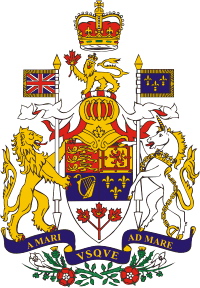 алерій
Редько, Юрій Федусенко, Мар’яна
Сідун
алерій
Редько, Юрій Федусенко, Мар’яна
Сідун
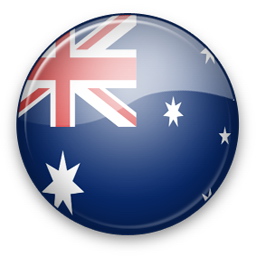
Сanada and Australia
i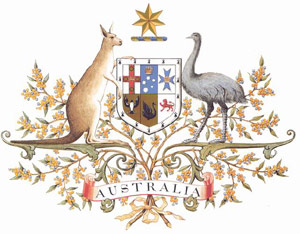
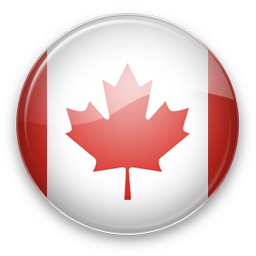 n
Focus
n
Focus
НАВЧАЛЬНИЙ ПОСІБНИК
ІЗ КРАЇНОЗНАВСТВА
Схвалено до використання
в навчально-виховному процесі
Схвалено Міністерством освіти і науки, молоді та спорту України до використання
в навчально-виховному процесі
(протокол № 1 від 03 березня 2011 року)
Затверджено Вченою радою Інституту педагогіки НАПН України
(протокол № 3 від 24 лютого 2011 року)
рецензенти:
Коваленко О.Я. – головний спеціаліст департаменту загальної середньої та дошкільної освіти Міністерства освіти і науки, молоді та спорту України
Топузов О.М. – доктор педагогічних наук, професор, заступник директора Інституту педагогіки НАПН України.
Потеря А.С. – вчитель англійської мови. Кагарлицька ЗОШ І-ІІІ ступенів №1., Київська область.
Кафедра англійської філології Мукачевського державного університету (зав. кафедри Теличко Н.В. – канд. пед. наук, доцент).
Навчальний посібник „Сanada and Australia in Focus” вміщує короткі відомості про Канаду й Австралію, міфи й легенди цих країн із прозорою фабулою, різноманітні за змістом, дібрані з урахуванням сфери інтересів і потреб учнів / студентів. Запропоновані тексти ілюструють особливості суспільного життя Канади й Австралії: соціальної, історичної, релігійної та культурної сфер. У навчальному посібнику пропонується список лексичних одиниць, глосарій та словник. До кожного з автентичних текстів додаються різноманітні вправи і завдання, що дозволяють зацікавити учнів / студентів, забезпечити їхню комунікативну активність, здійснювати контроль рівня сформованості їхніх іншомовних комунікативних навичок і вмінь, надати учням / студентам можливість самостійно себе оцінити, порівняти власні навчальні досягнення.
Посібник може бути корисним для учнів загальноосвітніх навчальних закладів, студентів педагогічних факультетів університетів, вчителів і викладачів, а також для усіх тих, хто вивчає англійську мову самостійно.
Від авторів
Розвиток економічних і соціально-політичних зв’язків України з іншими державами світу, її євроінтеграційні наміри, глобалізація усіх сфер життєдіяльності, зокрема можливість для сучасної молоді отримати середню та вищу освіту за кордоном зумовлюють переглянути деякі напрями розвитку змісту іншомовної освіти та визначити її пріоритетні стратегії. Не завжди зміст іншомовної освіти відповідає реаліям життя, інтересам нинішніх учнів і студентів. Значною мірою він залежить від особистісних здібностей, темпераменту та потреб людини, від ставлення її до майбутньої професії та готовності успішно за нею працювати.
Зміна поглядів на іноземну мову як важливий засіб міжкультурного спілкування, посилення ролі та значущості культурологічної компетенції зумовлюють переглянути деякі усталені погляди на процес іншомовної освіти.
З метою створення ефективного навчально-комунікативного середовища для формування у старшокласників / студентів культурологічної компетенції пропонується навчальний посібник „Canada and Australia in Focus”. За своїм змістом і структурою він сприяє розширенню уявлень про англомовні країни світу, а комплекси вправ і завдань залучають до активної творчої і соціально значущої діяльності.
Посібник містить короткі відомості про особливості суспільного життя Канади й Австралії: соціальної, історичної, релігійної та культурної сфер, а також міфи, легенди, перекази із прозорою фабулою, різноманітні за змістом, дібрані з урахуванням сфери інтересів і потреб сучасної молоді. У навчальному посібнику пропонується список лексичних одиниць, глосарій та словник. Система вправ і завдань дає можливість зацікавити учнів / студентів, забезпечити їхню комунікативну активність, здійснити контроль рівня сформованості іншомовної комунікативної компетенції, надати їм можливість самостійно себе оцінити, порівняти власні навчальні досягнення.
Посібник може бути корисним для учнів загальноосвітніх навчальних закладів, студентів педагогічних факультетів університетів, вчителів і викладачів, а також для усіх тих, хто вивчає англійську мову самостійно.

Сanada

Imagine you are hiking on a meandering trail through one of Canada’s spectacular national parks. As you breathe in deeply, smelling the natural perfume of the evergreens surrounding you in this particular location, you pause to wonder, “Have I experienced Canada before?”.
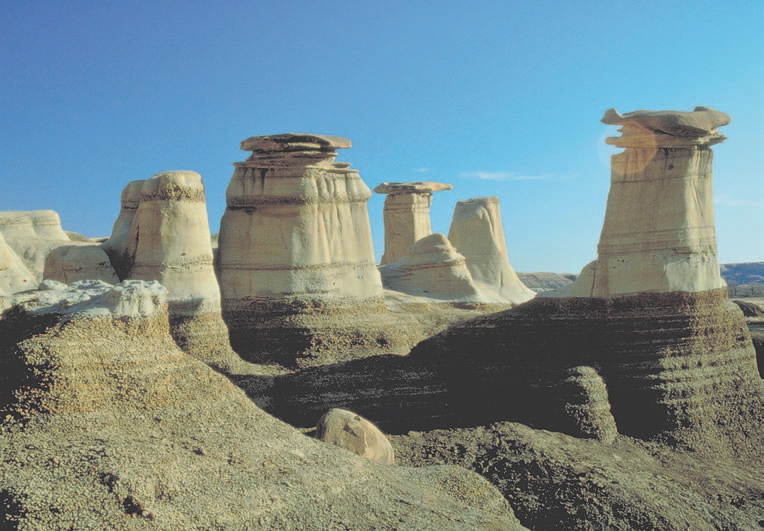 With
a land area of 3.8 million square miles (nearly 10 million square
kilometers), Canada is the world’s second-largest country. It also
dominates the northern portion of the North American continent. Three
oceans – the Pacific, Arctic, and Atlantic— border Canada’s
shores. An undefended land border of 5,524 miles, the longest in the
world, is shared with the continental United States to the south and
with the state of Alaska to the northwest. Because of Canada’s
tremendous size, the mountains merge with the gently rolling hills of
the interior plains and the arctic tundra with ease. Canada’s
vibrant cities and liberal history for welcoming immigrants make this
country a desirable home for some 31 million people. This population,
however, when considered with the vast land area, gives Canada one of
the world’s lowest population densities
–
about
8 people per square mile. Marked regional differences are visible in
Canada’s physical and human landscapes. The diversity of Canada’s
physical environment ranges from the quiet coves and beaches of the
Atlantic Provinces to the fertile grasslands of central Canada’s
prairies.
With
a land area of 3.8 million square miles (nearly 10 million square
kilometers), Canada is the world’s second-largest country. It also
dominates the northern portion of the North American continent. Three
oceans – the Pacific, Arctic, and Atlantic— border Canada’s
shores. An undefended land border of 5,524 miles, the longest in the
world, is shared with the continental United States to the south and
with the state of Alaska to the northwest. Because of Canada’s
tremendous size, the mountains merge with the gently rolling hills of
the interior plains and the arctic tundra with ease. Canada’s
vibrant cities and liberal history for welcoming immigrants make this
country a desirable home for some 31 million people. This population,
however, when considered with the vast land area, gives Canada one of
the world’s lowest population densities
–
about
8 people per square mile. Marked regional differences are visible in
Canada’s physical and human landscapes. The diversity of Canada’s
physical environment ranges from the quiet coves and beaches of the
Atlantic Provinces to the fertile grasslands of central Canada’s
prairies.
Numerous lakes dot the rocky cradle of the Canadian Shield, where animals greatly outnumber the people (and mosquitoes outnumber animals!).
The great white
polar bear spends most
of its life alone, out
on the polar icepack,
hunting for seals.

The caribou is
a North
American cousin of the
reindeer. Caribou in the
arctic migrate with the
season in herds of 10,000,
heading north on to the
tundra in spring, south into
the forest during winter.

Diverse peoples sprinkled throughout the varied landscapes offer seasoning for Canada’s colorful heritage and history. Populated historically with aboriginal (native) populations, early cultures were able to take advantage of Canada’s blessing of abundant natural elements. Fish, whales, buffalo, and other forms of wildlife were life-sustaining resources. Numerous water routes eased travel and provided access to the interior of the country and additional resources.

The richness of the country’s resource base also attracted European explorers and settlers who began arriving, with an inquisitive purpose, nearly five centuries ago. This mysterious land offered potential to fulfill a quest for the Northwest Passage, a desired route sought between Europe and the rich markets of the “Orient.” Centuries-long pursuits would bring extended contacts with aboriginal peoples already populating Canada. Reliance on aboriginal knowledge was beneficial for these explorations. Maps were sketched from memory on birch bark, in the snow, and on the ground by the aboriginal peoples. This wealth of knowledge was often incorporated onto maps drawn by early European explorers. It was during one of these European meetings with Iroquoian peoples that the name of Canada was first applied. French explorer Jacques Cartier inquired about the land he was exploring in 1535 near present-day Québec City. The Iroquoian response was “kanata,” the Huron-Iroquois word for “village” or “settlement.” Maps in 1547 thus began showing reference to land north of the St. Lawrence River as “Canada.”
Today Canada’s land area alone is almost 4 million square miles (nearly 10 million square kilometers). The U.S.– Canadian border stretches for 5,524 miles, and some southern portions of Canada dip below the more northerly U.S. cities. Canada’s three other borders are bounded by oceans, holding within them land that varies from ice-topped mountains to fertile farmland.

Australia
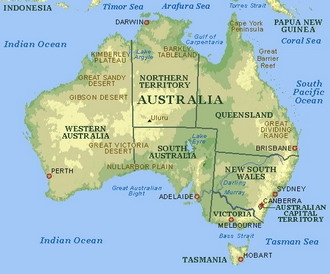
Australia is the smallest continent. It covers about 2,978,100 square miles (7,713,243 sq km). It is about the size of the United States. Australia is like nowhere else in the world. Kangaroos, koalas, and other interesting animals live there. Australia also has fine beaches and cities. This warm continent is an exciting place to be.
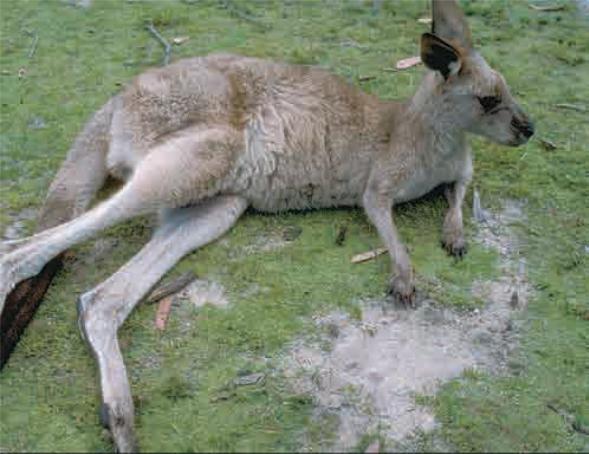
A hemisphere is half of the earth. The top half of the earth is the Northern Hemisphere. The Southern Hemisphere is the bottom half of the earth. Australia is in the Southern Hemisphere. This is why some people call Australia the Land Down Under.
The main part of Australia is an island. It has water on all sides. Australia lies between the Indian Ocean and the Pacific Ocean. Tasmania is also part of Australia. It is a smaller island to the south. There is only one country on the continent of Australia. It is also called Australia. It is the sixth-largest country in the world. Australia’s six states and two territories are: New South Wales, Victoria, Queensland, South Australia, Western Australia, Tasmania, Northern Territory, Australian Capital Territory.
Australia’s full name is the Commonwealth of Australia. The common language of Australia is English. About 18 million people live in Australia. Most Australians live near the coast.
The first Australians were Aborigines. They came to Australia about 40,000 years ago. The Aborigines hunted animals and gathered plants for food. Many of them died when Europeans came to Australia. More than 300,000 Aboriginal people live in Australia today.
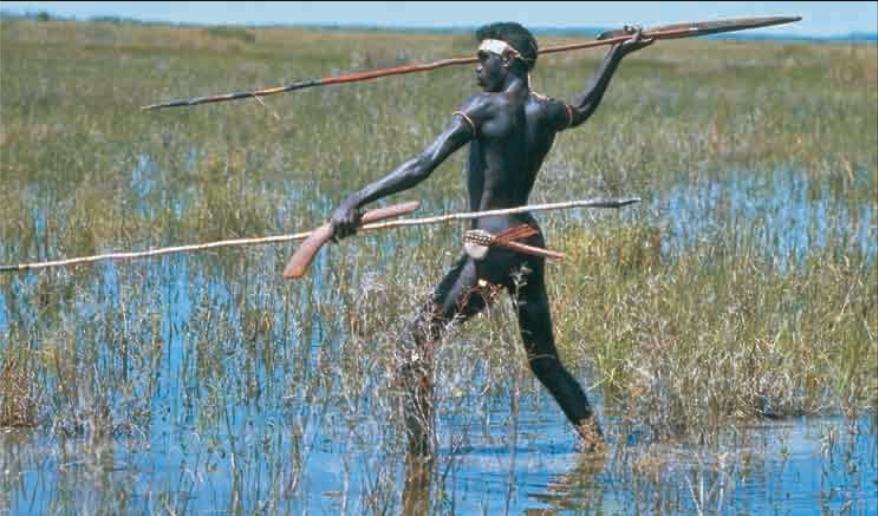
An Aboriginal man hunting for fish.
Deserts get less than 10 inches (25 cm) of rain each year. Australia’s Western Plateau has three main deserts: Great Sandy Desert, Gibson Desert, Great Victoria Desert. Australia’s desert land is not good for farming. But wild plants can grow there. Two desert flowers are the kangaroo paw and the sturt desert pea. They bloom after desert rains.
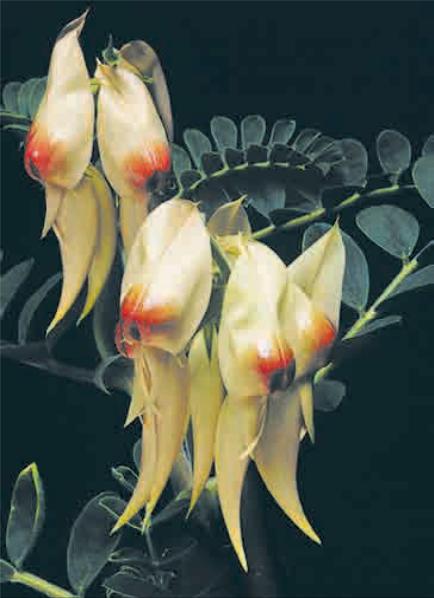
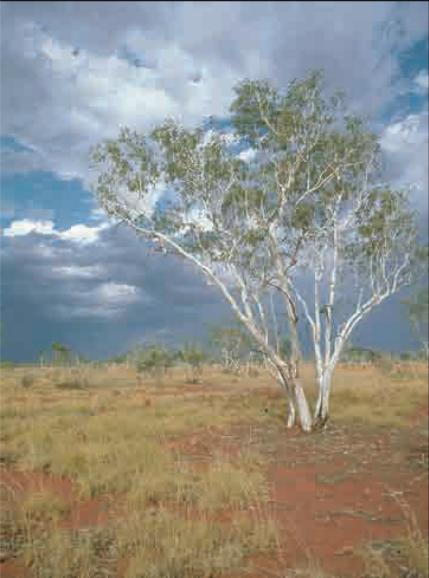
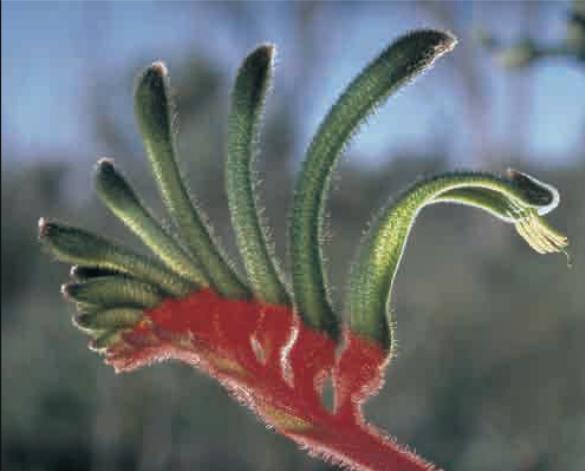
Sturt desert pea. Desert tree. Kangaroo paw.
East of the Western Plateau are the Central Lowlands. The Central Lowlands and the Western Plateau are mostly flat. In fact, Australia is the flattest continent. The lowest land of Australia is in the Central Lowlands. Australia’s lowest point is Lake Eyre. Lake Eyre is not always full of water. Many of Australia’s lakes stay dry for years. The Central Lowlands have flat, grassy land. This grassy land is good for raising sheep and cattle. But this land is too dry for farming.
Australia is famous for its hardwood eucalyptus trees. Eucalyptus trees are
sometimes called gum trees. People use these hardwood trees to build houses and furniture. Eucalyptus oil is important, too. It is used in medicine, soap, and cleaning supplies.

Australia has animals unlike any others in the world. One is the duck-billed platypus. This animal has a beak like a duck’s. But it is not a bird. The duck-billed platypus also has webbed feet. It lives in and near water.
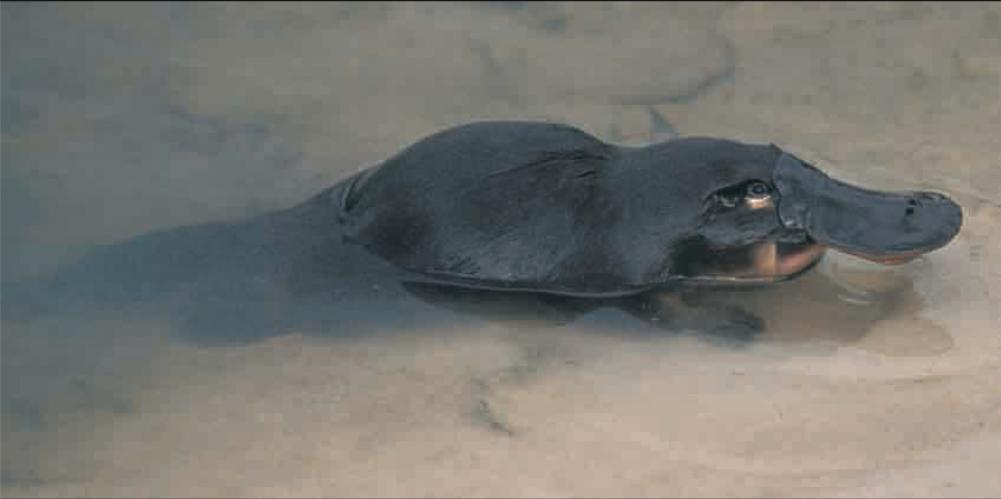 Duck-billed
platypus.
Duck-billed
platypus.
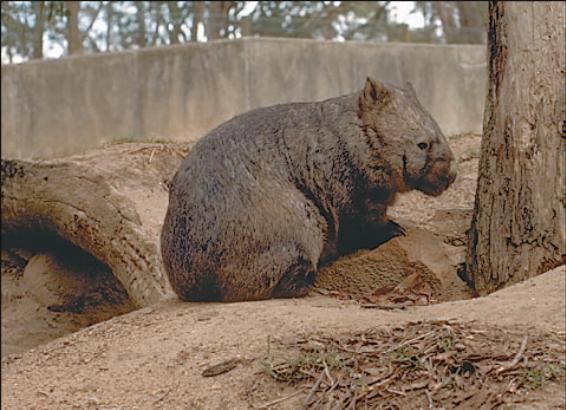 Wombat.
Wombat.
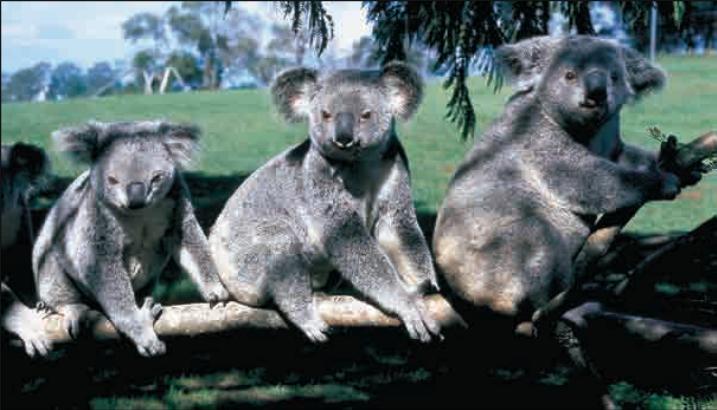 Koalas.
Koalas.


Еchidna A mother kangaroo and her baby.
Australia has many kinds of uncommon birds. There are kookaburras, colorful parrots, and emus. Emus are the second-largest birds in the world. They can grow to become six feet (two m) tall. Emus cannot fly. But they can run as fast as 30 mph (48 kph).
 Kookaburra.
Kookaburra.
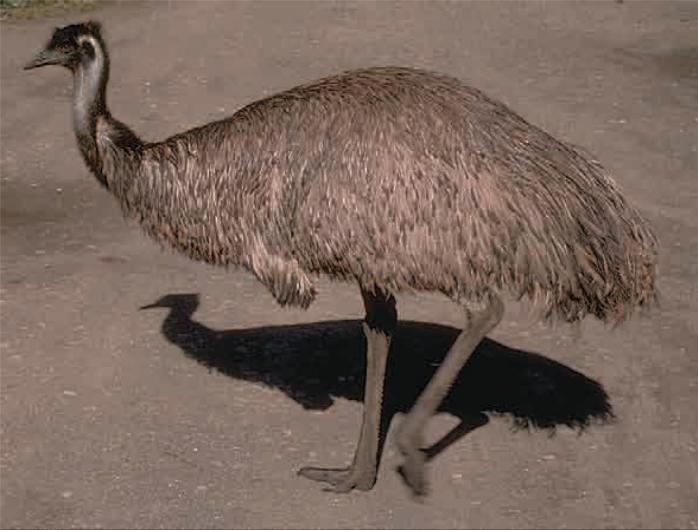 Emu.
Emu.
Thousands of people visit Australia’s Great Barrier Reef each year. It is the world’s largest coral reef. It is off Australia’s northeast coast. This reef has more than 1,200 miles (1,931 km) of coral. The Great Barrier Reef is made of living and dead coral. Coral are sea animals. The reef’s living coral is colorful and very beautiful.
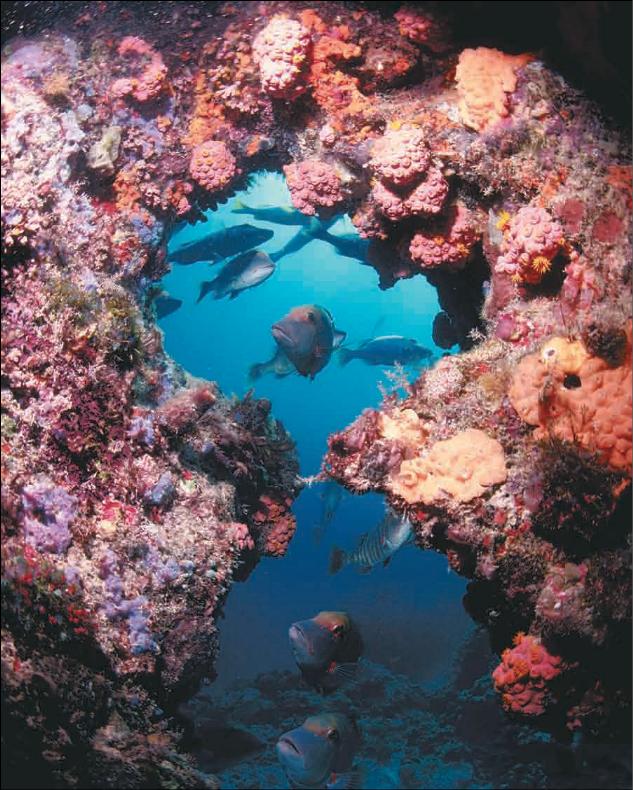
Australia’s Great Barrier Reef is made of coral.
Australia’s cities are full of interesting sights, too. People often visit the famous Sydney Opera House.
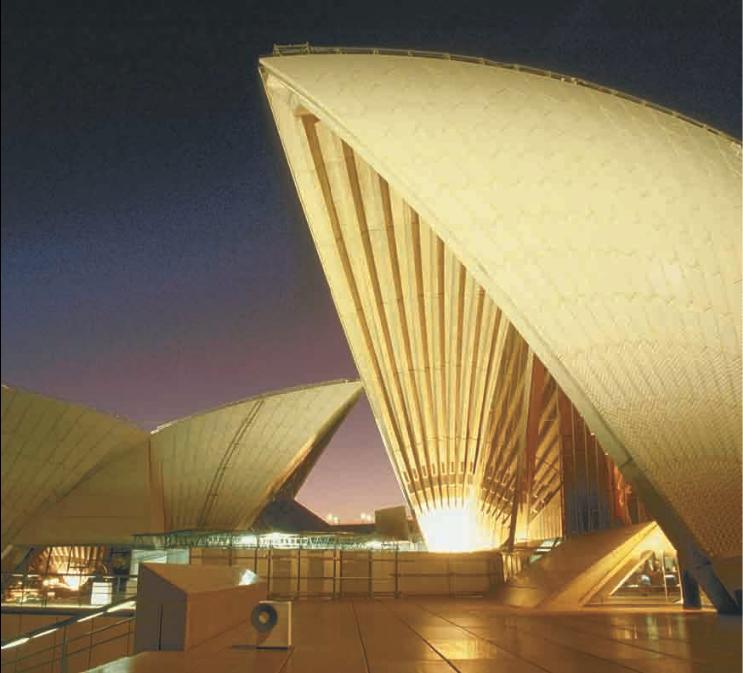
Sydney Opera House.
Canadian and Australian Myths and Legends
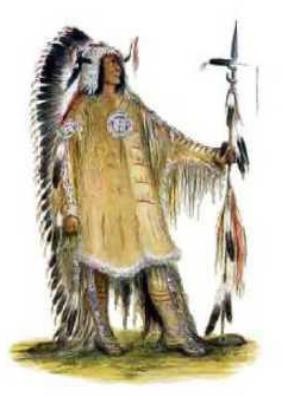
The Monkey and the Crocodile
Key words and expressions:
to yell
to slap
to come up with a plan
to be greedy
to be sad and miserable
Make up sentences with new words
Pre-reading task
1. How do you think? Is it possible for monkey and crocodile to be good friends?
2. Divide into two groups. Make up a list of advantages and disadvantages to be a monkey and a crocodile. Share your ideas.
Reading
A long time ago a monkey lived in a great fig tree on the riverbank. Life was good for him. He grew big and strong eating the tree's fruit. A lot of crocodiles lived in the river and one of them watched the monkey for a long time as he ate and slept in the tree.
“That monkey's heart must taste so sweet from all the fruit he eats” the crocodile thought to herself. “I want to eat it”.
She turned to her husband and said “See the big monkey up there in that tree. Bring me his heart, I want to eat it”.
Her husband looked up at the monkey in the tree and then looked at his wife.
“But the monkey lives high in the tree and I’m here in the river. How can I catch him?”
“I don’t care how you do it, just bring me his heart” yelled his wife, slapping the water angrily with her tail.
Her husband knew there was no way of talking her out of something, once she had made up her mind. She wouldn’t talk to him again until he brought her the monkey’s heart.
“Ok, Ok, calm down, I’ll think of something, dearest” he said.
The crocodile thought and thought and finally came up with a plan.
“I know what I’ll do” he said to himself. “I'll trick the monkey into riding on my back”.
The crocodile swam closer to the tree.
“Hello Mr Monkey. How are you today?” he called out, smiling and trying to sound friendly. He wasn’t too bright. When he smiled he showed all his big teeth.
“I'm fine, thank you” said the monkey, trying not to look scared as he stared down from the tree at the open mouth with all those big sharp teeth.
“Mr Monkey, why do you only eat the fruit from that fig tree when there are so many juicy mangoes on trees on the island in the middle of the river?” asked the crocodile.
“Because I can’t get across the river, the water is too deep” answered the monkey.
“No problem, you can ride on my back and I'll take you over there” said the crocodile.
The monkey didn’t trust the crocodile completely, but he was greedy and he wanted to taste all those juicy mangoes on the island. So he jumped down onto the crocodile’s back.
“Hold on tight and off we go” said the crocodile.
The crocodile had only swum a little way when he dived under the water.
“Why did you do that?” said the monkey, spluttering and spitting out water. “I could have drowned”.
“You are going to drown” said the crocodile. “I'm going to hold you under the water and kill you. My wife wants me to bring her your heart so she can eat it.”
“Ah, you should have told me before we left” said the monkey. “I didn’t bring my heart with me. I don’t keep it inside me all the time because it could get knocked to pieces from all that jumping around in the tree” he said. "Take me over to the island and after I've eaten some mangoes, we'll go back to my tree and I'll get my heart for you” said the monkey.
“No way, monkey” said the crocodile. "We’re going back for your heart first and then we’ll see about the mangoes.”
“Fair enough, you’re the boss” said the monkey.
When they got back to the tree the monkey jumped off the crocodile’s back and ran up high into the tree.
The monkey yelled down at the crocodile “You dumb crocodile, who ever heard of anyone keeping their heart up a tree. You may be bigger than me and have lots of sharp teeth but you're not smarter than me. My heart is inside me, come up here and get it if you can”.
The crocodile realised he'd been tricked. He was sad and miserable. “This is not good. How am I ever going to explain this to my wife?” the crocodile thought to himself. “She so wanted to taste that monkey’s heart”. A tear fell down his cheek as he swam back to his wife.
Comprehension check
Put the following events (A-F) in the right order. Number them (1-6).
a. The crocodile thought and thought and finally came up with a plan.
b. The crocodile realised he'd been tricked.
c. A long time ago a monkey lived in a great fig tree on the riverbank.
d. When they got back to the tree the monkey jumped off the crocodile’s back and ran up high into the tree.
e. The monkey didn’t trust the crocodile completely, but he was greedy and he wanted to taste all those juicy mangoes on the island.
f. Her husband looked up at the monkey in the tree and then looked at his wife.
a |
b |
c |
d |
e |
f |
|
|
1 |
|
|
|
WRITIHG
Write an article of about 100-120 words to a school newspaper. Express your point of view on the legend.

